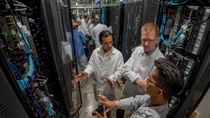Media
BASF operates largest supercomputer for industrial chemical research
The start of “Quriosity” marks an important step towards the digitalization of BASF’s R&D.

BASF understands the increased need to use powerful digital technologies in research and development. That’s why the chemical company decided to purchase a supercomputer from Hewlett Packard Enterprise that enables processing of a greater number and more complex computations in shorter periods of time.
It took just one year from initial internal planning meetings to start up of BASF’s new supercomputer, but now it’s finally running. The custom-designed computer, named “Quriosity” following an online naming contest among employees—has a computing power of 1.75 petaflops (1 petaflop equals one quadrillion floating point operations per second) which offers about 10 times the overall computing power previously available to BASF’s R&D teams. Simply put, the multitude of several hundred computer nodes can work at the same time on very complex modeling and simulation tasks.
The supercomputer BASF purchased is based on the latest generation of HPE Apollo 6000 systems and has Intel Xeon Scalable processors. BASF’s strategic goal is to decisively take advantage of the enormous opportunities that digitalization offers along the entire value chain. In doing so, research and development plays a key role when it comes to further increasing innovation strength and competitiveness by using new technologies. In particular, the new supercomputer will enable BASF experts to efficiently investigate complex questions, which will further shorten the time it takes to launch new products.
The system was assembled by HPE in Houston, Texas; that is also where its performance has been measured. Afterwards the supercomputer was shipped to BASF’s Ludwigshafen, Germany site where it has been put into operation and is now running at full capacity. The first calculations have already been performed.
In the latest November 2017 ranking of the 500 largest computing systems in the world, BASF’s supercomputer came at number 71, and number 1 in the chemical industry.

“While supercomputers have been used by industrial companies for decades, Quriosity is the world’s largest supercomputer used for industrial chemical research today,” said Stephan Schenk, Ph.D., Team Lead, High Performance Computing & Databases, BASF Germany. “It will offer our researchers computing power like no other company in our industry.”
But what will be the main tasks of the new supercomputer? There is a queue of projects where the new computer is to be used, said Schenk. Tasks in need of significant computing power, such as simulations of industrial catalysts, crop protection products and materials are among the first computational jobs being run.
The focus of catalysts’ research is to increase their efficiency and therefore sustainability by decreasing raw material input and generating less waste. It is also important that crop protection products work more efficiently, and in a more targeted matter, to better meet current and future customer requirements. For the modeling of materials and systems, such as foams and formulations, the increased computing performance allows more precise predictions regarding functionality and properties, according to BASF experts.
“The new supercomputer will enable our R&D teams to very efficiently investigate complex questions and further shorten the time it takes to launch new products. Until now, we could only change a few parameters in our computer simulations and had to wait for results,” Schenk concluded. “Now far more complex models are possible. This could result in substantially reduced development times and the recognition and exploitation of previously unknown relationships, encouraging completely new research approaches. This will allow us to even better meet our customers’ demands for high-class innovations based on chemistry.”
Published by Anna Spiewak.
For media inquiries or to repurpose this article, contact Lisa Brown.